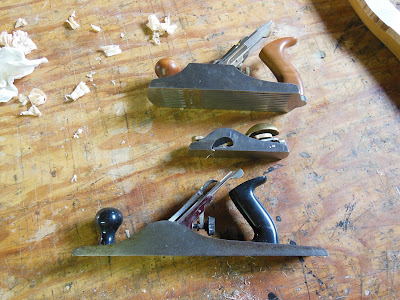Let's start with the general condition of the instrument. The Erard log books says this instrument was built in 1843, and is veneered with Courbaril, which is a south American hardwood similar to Rosewood. The present condition of the case is good, although it was recently refinished with nitro-cellulose lacquer, which is decomposing. In many places the veneer shows signs of telegraphing, which indicates movement of the structure beneath. The treble corner, visible in this photo, shows a slight change in elevation,
The log book also tells us that the piano originally had six bars. A close look at the photo above shows 7 bars, the bar in extreme bass was added more recently, probably sometime in the 1990's. The four transverse bars, which are welded in are also a recent addition.
The log book also tells us that the piano originally had six bars. A close look at the photo above shows 7 bars, the bar in extreme bass was added more recently, probably sometime in the 1990's. The four transverse bars, which are welded in are also a recent addition.
In the above photo we see two of the more interesting additions to this instrument. Two clamps which although ugly, and out of place, appear to have been cast and machined from Bronze, which shows that considerable skill and expense was brought to bear (more about these two guys later).
If you are interested in seeing the Erard log books here is the link http://archivesmusee.citedelamusique.fr/pleyel/archives.html
The original tri-chord arrangement in the plain wire sections was converted to bi-chords with the exception of six unisons in the tenor section, which remained tri-chord. This was a response to the instrument previously being strung with wire that was too large. This larger wire tore the instrument apart. My preliminary measurements indicate that this was, originally, a fairly low tension scale, using thin wire. The problem with using modern wire of the same thickness, is that, modern wire, being stronger than the original wire, does not reach a sufficient percentage of its break-point, and as a result sounds lousy, and will not hold a stable tuning. Hence the bi-chords. The correct fix is to use wire of a lower tensile strength, and return the instrument to its original scale. I am going to elaborate more on this in a later post.
Next, an analysis of the pin-block....





Comments
Post a Comment